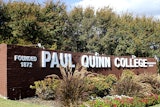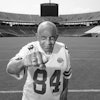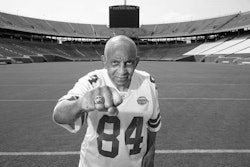The U.S. has produced more than its share of women and minority athletes who have made their marks and claimed Olympic glory. But behind the scenes is a different story.
Ethnic presence in the U.S. Olympic movement is so rare that when it does occur it’s viewed as a blip on the radar screen. Dr. LeRoy Walker, president of the U.S. Olympic Committee, was never comfortable with that state of affairs.
To help remedy the situation, Walker, the USOC’s first Black chief executive, directed two task forces, one for women, one for minorities, to encourage diversity within the ranks of the USOC and the national federations that govern Olympic sports in the United States. Together they have developed lists of highly qualified administrators, educators and other professionals who are willing to volunteer to do the many jobs necessary to participating in the Olympics. As a respected coach and athletic administrator, Walker knows the score. He was the head coach of the U.S. men’s track and field team at the 1976 Olympics and has served in a variety of capacities within the USOC since 1977.
“Diversity has little to do with gender or ethnicity,” says Walker, who served first as vice-chancellor then as chancellor at North Carolina Central University for 12 years. “It’s more about us missing out on utilizing an untapped resource of talented and skilled people.”
Dee Todd, assistant commissioner of the Atlantic Coast conference, heads the minority task force. The former women’s track coach at Northwestern and Georgia Tech has a keen interest in the ethnic makeup of the decision-making boards and committees within the USOC and the sports federations. Striving for ethnic balance, she says, can’t help but produce positive results.
“The Olympics are diverse,” Todd explains. “So it’s only reasonable that the administrative, behind-the-scenes part of it reflects what the Olympics are all about. In diversity there is strength. It can only make us a stronger organization.”
The task force has its own Olympic connections already. Billy Mills, Benita Fitzgerald, Stephanie Hightower and Chris Campbell are former Olympians who join Todd on the ad hoc group. Todd’s group started building its case for diversity by surveying the USOC and the 50-plus federations to determine the minority membership in those groups. For Todd, the survey results were disturbing, but hardly surprising.
“The numbers were what I thought they would be,” says Todd. “Over 90 percent of the USOC and the national governing bodies (of the federations) are 100 percent male and Caucasian.”
Initially, the response to the survey was next to nil. But after some USOC-generated persuasion, Todd’s task force got full cooperation. Of the 54 groups contacted, only one failed to provide the requested information. “It took some persistence to finally get the numbers,” she says. “People tend to get nervous about diversity in the workplace. It forces them to take a look at themselves.”
The task force pre-screened minority candidates for USOC-related work to assure some level of commitment. All have highly-honed skills in different areas of expertise, but they also have an interest in sports and a strong desire to work as USOC volunteers. The USOC initiative goes beyond speeches, press releases and TV sound bites.
Thanks to USOC and corporate financial backing, the task forces received $200,000 to pay for leadership training seminars, designed to help prepare minorities and women for meaningful roles in the U.S. Olympic movement. Two leadership seminars were held at the U.S. Olympic Training Center at Colorado Springs, CO. At those four-day workshops, a total of 100 women and minorities got an overview of the USOC and the Olympic movement, which included the input of several sports federations and how their roles fit into the USOC game plan.
The range of expertise among those who received leadership training runs the gamut from athletic and college administrators to lawyers, educators and media. “Just looking at the backgrounds of the people at the seminars made it very positive for everyone involved,” says Todd. “Diversity doesn’t have to be a negative experience. “
Identifying and acclimating people to serve in the USOC circles is part of the process in facilitating appointments to boards and committees. But Todd knows the process can’t stop there. Her group has compiled a directory of minorities that will help the USOC and sports federations select the people who best fit their individual needs.
Walker, whose four-year term at USOC chief ends in October, is pleased with these latest developments. As far as he’s concerned it’s a win-win situation. The governing bodies now have better access to this newly-developed pool of talent. “It’s been even better than anticipated,” Walker says. “When I first took over as president, I didn’t have that kind of access. But now, the IOC and the new president will have a corps of 100 people to choose from. I’m confident that a large number of those folk will get the opportunity to serve and contribute.”
COPYRIGHT 1996 Cox, Matthews & Associates
© Copyright 2005 by DiverseEducation.com















